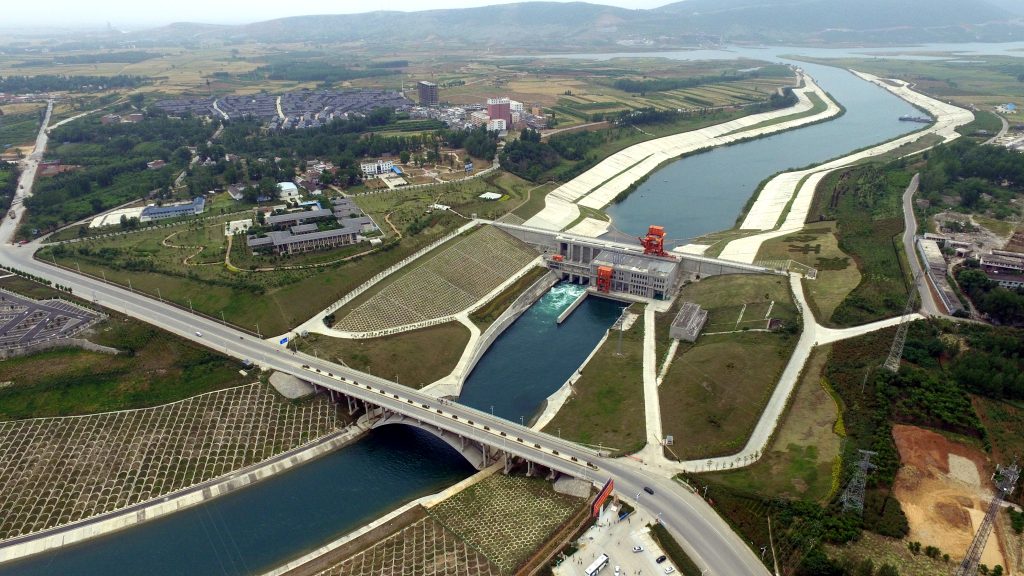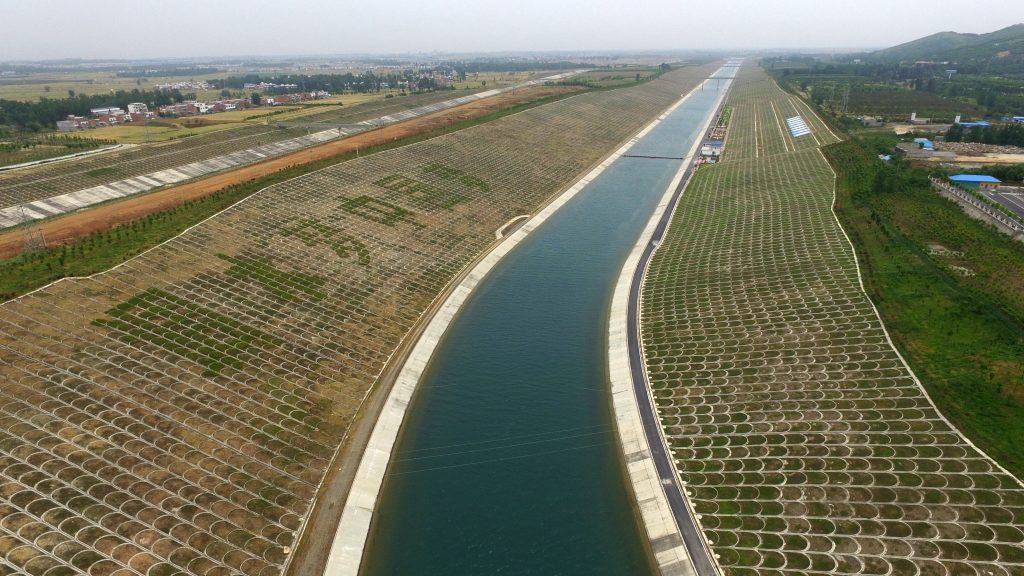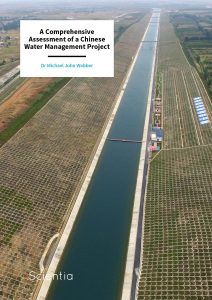Dr Michael J Webber | A Comprehensive Assessment of a Chinese Water Management Project
Transferring water from one river basin to another is supposed to help us better manage our planet’s water resources. The South-North Water Transfer Project (SNWTP), an inter-basin water transfer effort in China, can transfer 25 billion cubic metres of water per year over long distances. Dr Michael J Webber of the University of Melbourne and his colleagues have been exploring the benefits and challenges of the SNWTP, to assess its socio-political, environmental, and economic impacts. His research aims to gain valuable insights about the politics of vast technologies, and how inter-basin water schemes might be managed.
China’s South-North Water Transfer Project
As the climate crisis causes extreme changes in rainfall patterns, floods, and droughts, it introduces new challenges for the management water resources. Over the next few decades, access to clean water could thus become scarce or unpredictable in many parts of the world.
In these uncertain times, research evaluating water management strategies is of utmost importance, as it could inform political decisions and help to ensure that more people have access to clean water. One renowned water management strategy entails the transfer of water from one river basin to another, to shift water from where it is abundant to where it is scarce.
China’s South-North Water Transfer Project (SNWTP) is one of the world’s largest inter-basin water transfer efforts, with the capacity to transfer 25 billion cubic metres of water over distances of 1,400 kilometres every year. The project relies on an extensive infrastructure network that connects four major river basins in China, spanning six provinces and three megacities inhabited by a total of 700 million people.
Given its magnitude, the SNWTP is an ideal case to study the possible consequences and challenges associated with large basin water transfer efforts. So far, however, most studies related to the SNWTP primarily focused on the project’s environmental impact, engineering underpinnings, and financial aspects.
In collaboration with colleagues in Australia and China, Dr Michael Webber has been conducting research to fill this gap, by exploring the socio-political and hydrological motives, processes, and consequences of the SNWTP. His findings offer valuable insight that could guide the decisions of governments that are investing in large-scale water transfer projects.

A Comprehensive Evaluation of the SNWTP
Over the past few years, Dr Webber and his colleagues have carried out many field-based studies exploring different aspects of the SNWTP. These studies are part of a broader research effort aimed at better understanding the goals of the project, its associated governance strategies, and the ways in which it changed the distribution of water, money, pollution, and people across China.
‘I seek to integrate hydrological scientific studies with social scientific studies to attain an interdisciplinary understanding of the issues that water management has to solve, the means that are brought to seek solutions, and the consequences that follow from those means,’ says Dr Webber. ‘In the present project, the team that I lead is seeking to use the South-North Water Diversion Project as a vehicle through which to approach those general concerns.’
In one of their previous studies, Dr Webber and his colleagues looked at how water was managed and supplied in Shanghai, the most densely populated urban area in China. Their new research effort builds on this previous work, yet it shifts its focus to the SNWTP.
‘Our research project aims to investigate the motives, processes, and socio-political and hydrological consequences of the SNWTP,’ says Dr Webber. ‘It critically analyses its governance regime, its effects on local and regional flows of water, money, people, pollutants, production and political authority, and the interactions between these systemic and local changes. This will produce new knowledge about the politics of vast technologies, the management of inter-basin water schemes in Australia and globally, and socio-political change in China.’
A History of Water Governance in China
In one of their papers, Dr Webber and his team summarised the evolution of water governance regimes in China between 1998 and 2018. In 1999, after several consecutive years of drought in Northern China, Wang Shucheng, Minister of Water Resources at the time, encouraged researchers and those involved in water management policies to start discussing the water management challenges that China would face in the 21st century and introducing new potential strategies.
This led to a series of reforms and initiatives aimed at better allocating water resources across the country, including the ‘Building a water-saving society’ reform, the trading of water between Chinese provinces, and amendments to the Water Law. In the years that followed, the Chinese government significantly invested in building water management infrastructure, while also introducing water trading and a water rights system.
Dr Webber and his colleagues also outlined several important milestones in China’s water management, including the development of the SNWTP. Finally, they pinpoint two crucial and yet complementary trends in Chinese water governance, namely state control and marketisation.
‘Our analysis shows how experiments in water rights and water trading have continued alongside renewed growth in water supply infrastructure and continued state control of water rights and allocation,’ says Dr Webber. ‘We argue that instead of contradicting or supplanting each other, these two trends in water management are complementary, collectively contributing to a distinctive governance regime that serves broader political and economic goals as well as the goal of water security.’

Shortcomings and Challenges of the SNWTP
In a 2018 study, Dr Webber and his colleagues set out to answer several questions associated with the evolution of the SNWTP, its impact, and the socio-political challenges associated with it. To do this, they analysed data collected both by members of their team and by other research groups in the past.
Their findings suggest that while the project did effectively provide water to some regions of China, it encountered several socio-political, health, and environmental challenges along the way. For instance, they found that there are still significant issues with the management of transferred water under specific jurisdictions.
In addition, while China’s central government imposed strict water quality targets, it is still proving difficult to ensure that these are met in all regions where water is transferred. Dr Webber and his colleagues found that although the SNWTP is helping to reduce the overexploitation of groundwater in Beijing, it is also highly energy intensive, which raises crucial questions about its sustainability.
Moreover, the researchers found that some provinces in China are benefitting from the transfer of water, while others are facing long-term socio-economic consequences associated with the displacement of their water resources. For example, the intrusion of salt water into Shanghai’s water supply is just one of the consequences of the SNWTP that Dr Webber and his team forecast. In October of 2022, one such intrusion put Shanghai’s water security at risk.
The Case of the Shandong Province
In one of their most recent papers, Dr Webber and his colleagues specifically examined issues faced in Shandong Province, a region on the Eastern coast of China that first gained access to water through the SNWTP in 2013. By analysing various data sources collected in China, Dr Webber and his colleagues showed that planners consistently overestimated the region’s future water demand, which further encouraged the Chinese government to invest in the SNWTP.
Between the time in which the SNWTP was designed and constructed, however, water had become more readily available in Shandong, as supplies from the Yellow River became more reliable and local engineering systems were improved. When the SNWTP started supplying water to the region, therefore, Shandong’s need for it had decreased substantially.
Dr Webber’s paper also highlights several difficulties that Shandong Province experienced in trying to manage the delivery of water and paying for it. These include unfinished local projects aimed at connecting cities to the main canal, high water prices, conflicts and misunderstandings between stakeholders, and ambiguous management policies.
As a result of poor water demand estimations and these water management challenges, in 2016 cities in Shandong used an average of less than 10% of their allocated quota of SNWTP water, with seven of these cities using none. These findings and statistics offer a valuable example of how basin water transfer projects can have long-term and inadvertent consequences.

Guiding Future Decisions
The recent work by Dr Webber and his colleagues could have numerous far-reaching implications. Most notably, as there are now hundreds of inter-basin transfer projects worldwide, understanding their potential risks and shortcomings could help to prevent or minimise their undesirable long-term consequences.
‘Our findings suggest that actually managing a huge water network like that based on the SNWTP tests the capacities of even the strongest political systems; sub-national governments play critical roles in managing the SNWTP, even though it is a national project,’ says Dr Webber. ‘Chinese methods of integrating state direction and market allocation in managing water provide important insights into state-market relations in Western societies.’
In addition to gathering information about the challenges and opportunities associated with inter-basin water transfer efforts, Dr Webber’s findings could improve the understanding of how socio-environmental changes are perceived and dealt with in China. Combined, these insights could guide the development of both natural resource management and security policies.
‘There are currently proposals to increase the transfer of water across river basins in every continent, though this is a contentious practice,’ says Dr Webber. ‘An outcome of this research will be integration of new knowledge into debates, programs and policies on inter-basin water transfers, which will benefit the sustainability of the world’s water resources.’
SHARE
DOWNLOAD E-BOOK
REFERENCE
https://doi.org/10.33548/SCIENTIA848
MEET THE RESEARCHER

Dr Michael John Webber
School of Geography, Earth and Atmospheric Sciences
University of Melbourne
Melbourne, Victoria
Australia
Dr Michael Webber is a Professor Emeritus and Honorary Professorial Fellow at the University of Melbourne. He holds a BA in Geography from Cambridge University and a PhD in Geography from the Australian National University. Before he started working at the University of Melbourne, Dr Webber taught Geography at Australian National University and McMaster University for several years. He was also a visiting professor at numerous other academic institutions, including the University of Cincinnati, University of Bristol, University of Sydney, and East China Normal University. Since 2008, he has spent the equivalent of two years in China, including serving as a Professorial Fellow at China Three Gorges University. In addition to his research, Dr Webber has served as a consultant for the Australian government and other organisations, contributing to the implementation of numerous geography-related projects. For instance, he helped to prepare reports predicting the possible implications of emerging trends in regional development in Australia, the possible effects of migration on climate change, and outlining measures to improve research on sustainability in Australia.
CONTACT
E: mjwebber@unimelb.edu.au
W: https://findanexpert.unimelb.edu.au/profile/12932-michael-webber
KEY COLLABORATORS
Dan Chen, Hohai University
Zhaohui Luo, Nanjing Agricultural University
Sarah Rogers, University of Melbourne
Ian Rutherford, University of Melbourne
Mark Wang, University of Melbourne
Brian Finlayson, University of Melbourne
Chenchen Shi, Capital University of Economics and Business
Wenjing Zhang, University of Liverpool
Xiao Han, Hohai University
Nahui Zhen, University of Melbourne
FUNDING
The major body funding this research is the Australian Research Council, through its Discovery Program.
FURTHER READING
M Jiang, M Webber, J Barnett, S Rogers, I Rutherford, M Wang, and B Finlayson, Beyond contradiction: The state and the market in contemporary Chinese water governance, Geoforum, 2020, 108, 246.
D Chen, Z Luo, M Webber, S Rogers, I Rutherfurd, M Wang, B Finlayson, M Jiang, C Shi, and W Zhang, Between project and region: The challenges of managing water in Shandong province after the South-North water transfer project, Water Alternatives 2020, 13, 49.
S Rogers, D Chen, H Jiang, I Rutherfurd, M Wang, M Webber, B Crow-Miller, J Barnett, B Finlayson, M Jiang, C Shi, and W Zhang, An integrated assessment of China’s South-North Water Transfer Project, Geographical Research, 2020, 58, 49.
M Webber, J Barnett, B Finlayson, M Wang, Water Supply in a Mega-City: A Political Ecology Analysis of Shanghai, Cheltenham, Edward Elgar, 2018. https://doi.org/10.1080/02508060.2020.1868125

REPUBLISH OUR ARTICLES
We encourage all formats of sharing and republishing of our articles. Whether you want to host on your website, publication or blog, we welcome this. Find out more
Creative Commons Licence (CC BY 4.0)
This work is licensed under a Creative Commons Attribution 4.0 International License. 
What does this mean?
Share: You can copy and redistribute the material in any medium or format
Adapt: You can change, and build upon the material for any purpose, even commercially.
Credit: You must give appropriate credit, provide a link to the license, and indicate if changes were made.
SUBSCRIBE NOW
Follow Us
MORE ARTICLES YOU MAY LIKE
Allison Balabuch – Professor Ann Brower Stahl | Bringing Archaeology to the Classroom and Beyond: The African Archaeology Review
The African Archaeology Review (AAR) journal recently celebrated its 40th anniversary. To mark this occasion, a special issue was compiled with an innovative theme: Archaeology for Education. To achieve this, the AAR editorial team assembled a group of academic researchers in archaeology with the proposition of writing articles collaboratively with educators that would make their research centred on Africa’s rich pasts accessible for use in school learning. The goal is to change the stories we tell about Africa both within and outside the continent.
Professor Martin Trefzer | Bridging Nature and Artificial Intelligence for Smart Electronics Technology
The ever-developing world of artificial intelligence (AI) stands at the tip of a transformative breakthrough. Professor Martin Trefzer from the University of York and Professor Jim Harkin from Ulster University have introduced a revolutionary approach to neural network design. They work on an electronic system based on AI that forms the basis of the cross-disciplinary project called Nervous Systems, which aims to build electronic neuromorphic devices with an artificial intelligence system mirroring the adaptability and responsiveness of biological neural systems.
Dr Jon Tore Lieng | Dynamically Installed Anchors for Floating Offshore Turbines
Effectively harnessing offshore wind presents a valuable opportunity to increase energy supplies. Floating wind turbines present several advantages over traditional fixed turbines in more shallow waters. Dr Jon Tore Lieng from Deep Sea Anchors and colleagues have developed a type of dynamically installed anchor to hold the structures in place while reducing both the costs and complexity associated with installation where cohesive seabed sediments are realised.
Professor Ken M Levy | The Boundaries of Free Will and Responsibility: From Academic Debate to the Real World
For almost thirty years, Professor Ken M Levy of Louisiana State University Law School has been thinking and writing about free will and responsibility. In several articles and his recent book, Free Will, Responsibility, and Crime: An Introduction (Routledge 2020), Professor Levy discusses a wide range of subjects, including the myth of the ‘self-made man’, whether psychopaths are culpable for their crimes, and the increasingly popular but highly controversial theory of responsibility scepticism. Professor Levy’s research has profound implications for law, ethics, and society.





